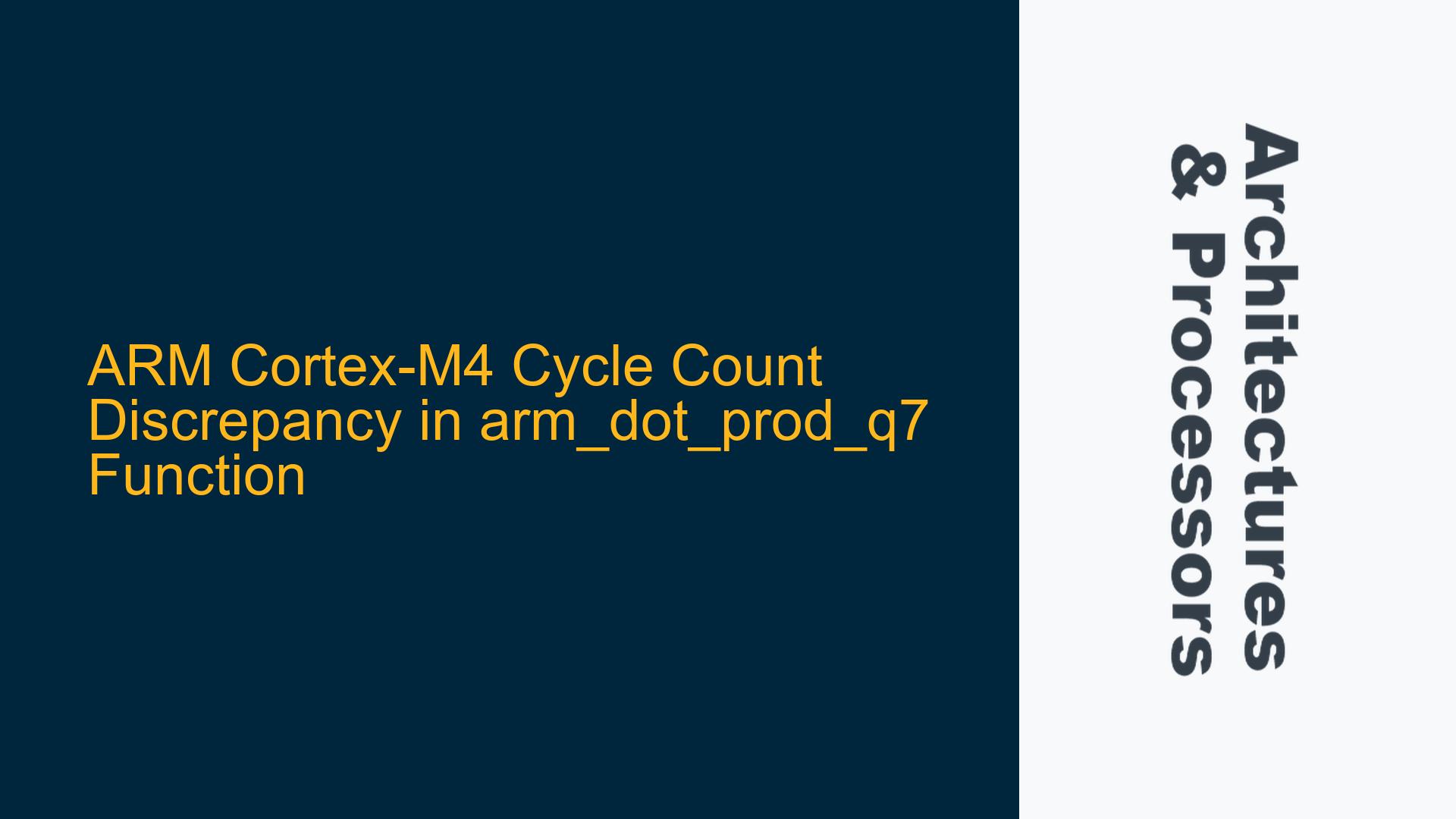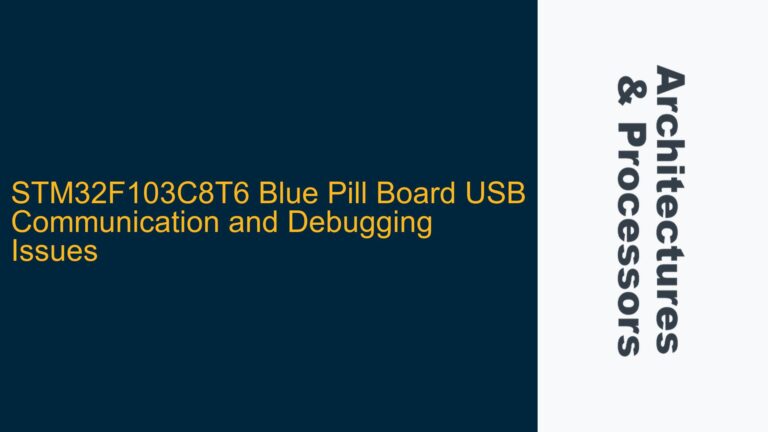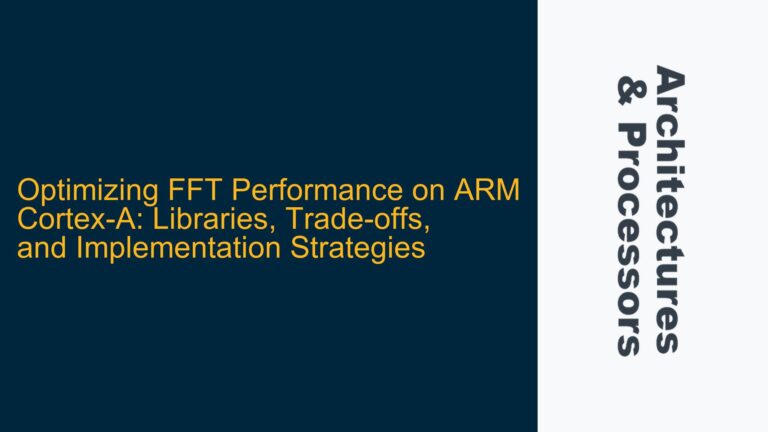ARM Cortex-M4 Cycle Count Discrepancy in arm_dot_prod_q7 Function
The ARM Cortex-M4 processor is widely used in embedded systems due to its balance of performance and power efficiency. One of the key features of the Cortex-M4 is its ability to execute Digital Signal Processing (DSP) instructions efficiently, which is crucial for applications such as audio processing, sensor data analysis, and control systems. The arm_dot_prod_q7 function is part of the ARM CMSIS-DSP library, which provides optimized DSP functions for ARM Cortex-M processors. The function computes the dot product of two Q7 format vectors, which is a common operation in DSP applications.
The expected cycle count for the arm_dot_prod_q7 function on the Cortex-M4 is 144 cycles, as per the ARM documentation and performance surveys. However, in practice, users have reported cycle counts as high as 910 cycles, which is significantly higher than the expected value. This discrepancy can have a substantial impact on the performance of real-time systems, where timing predictability is critical.
The cycle count discrepancy in the arm_dot_prod_q7 function can be attributed to several factors, including compiler optimizations, memory access patterns, and the specific configuration of the Cortex-M4 processor. Understanding these factors is essential for diagnosing and resolving the issue.
Compiler Optimizations and Memory Access Patterns
One of the primary factors that can influence the cycle count of the arm_dot_prod_q7 function is the level of compiler optimizations applied during the build process. The ARM Cortex-M4 processor supports a variety of compiler optimizations that can significantly impact the performance of DSP functions. These optimizations include loop unrolling, instruction scheduling, and the use of SIMD (Single Instruction, Multiple Data) instructions.
When the arm_dot_prod_q7 function is compiled with low optimization levels, the compiler may generate code that is not fully optimized for the Cortex-M4 architecture. This can result in additional cycles being spent on unnecessary memory accesses, branch instructions, and other overheads. For example, if the compiler does not unroll the loop in the arm_dot_prod_q7 function, the processor may incur additional cycle penalties due to loop control instructions.
Memory access patterns also play a crucial role in determining the cycle count of the arm_dot_prod_q7 function. The Cortex-M4 processor has a Harvard architecture, which means it has separate buses for instruction and data memory. However, the processor’s memory system is designed to prioritize low-latency access to frequently used data. If the arm_dot_prod_q7 function accesses data from non-cached or high-latency memory regions, the processor may stall while waiting for the data to be fetched, leading to an increase in cycle count.
Additionally, the alignment of data in memory can affect the performance of the arm_dot_prod_q7 function. The Cortex-M4 processor supports unaligned memory accesses, but these accesses may take additional cycles compared to aligned accesses. If the input vectors to the arm_dot_prod_q7 function are not properly aligned, the processor may incur additional cycle penalties.
Cortex-M4 Configuration and Peripheral Interactions
The configuration of the Cortex-M4 processor can also impact the cycle count of the arm_dot_prod_q7 function. The Cortex-M4 processor has several configurable features, such as the number of wait states for flash memory access, the presence of a floating-point unit (FPU), and the use of a memory protection unit (MPU). These features can influence the performance of DSP functions, including the arm_dot_prod_q7 function.
For example, if the Cortex-M4 processor is configured with a high number of wait states for flash memory access, the processor may stall while fetching instructions from flash memory, leading to an increase in cycle count. Similarly, if the FPU is enabled but not used in the arm_dot_prod_q7 function, the processor may still incur overheads related to FPU context switching.
Peripheral interactions can also affect the cycle count of the arm_dot_prod_q7 function. The Cortex-M4 processor is often used in systems with various peripherals, such as timers, communication interfaces, and analog-to-digital converters (ADCs). If these peripherals generate interrupts or require frequent servicing by the processor, they can disrupt the execution of the arm_dot_prod_q7 function, leading to an increase in cycle count.
Diagnosing and Resolving Cycle Count Discrepancies
To diagnose and resolve the cycle count discrepancy in the arm_dot_prod_q7 function, it is essential to follow a systematic approach that includes analyzing the compiler settings, memory access patterns, and Cortex-M4 configuration.
First, ensure that the arm_dot_prod_q7 function is compiled with the highest optimization level supported by the compiler. Most modern compilers, such as ARM GCC and ARM Clang, support optimization levels ranging from -O0 (no optimization) to -O3 (aggressive optimization). Compiling the arm_dot_prod_q7 function with -O3 optimization can significantly reduce the cycle count by enabling loop unrolling, instruction scheduling, and other optimizations.
Next, analyze the memory access patterns of the arm_dot_prod_q7 function. Ensure that the input vectors are stored in low-latency memory regions, such as SRAM, and that they are properly aligned. If the input vectors are stored in high-latency memory regions, such as external SDRAM, consider copying them to SRAM before calling the arm_dot_prod_q7 function. Additionally, use the __attribute__((aligned)) keyword to ensure that the input vectors are aligned to the appropriate boundary.
Review the configuration of the Cortex-M4 processor and ensure that it is optimized for the arm_dot_prod_q7 function. For example, if the arm_dot_prod_q7 function does not use the FPU, consider disabling the FPU to reduce overheads. Similarly, configure the number of wait states for flash memory access based on the specific flash memory used in the system.
Finally, consider using profiling tools to measure the cycle count of the arm_dot_prod_q7 function in different scenarios. Profiling tools, such as ARM Streamline, can provide detailed insights into the execution of the arm_dot_prod_q7 function, including the number of cycles spent on memory accesses, branch instructions, and other overheads. Use this information to identify and address any bottlenecks in the arm_dot_prod_q7 function.
Implementing Data Synchronization Barriers and Cache Management
In some cases, the cycle count discrepancy in the arm_dot_prod_q7 function may be due to issues related to data synchronization and cache management. The Cortex-M4 processor supports data synchronization barriers (DSBs) and instruction synchronization barriers (ISBs) to ensure that memory accesses are properly ordered and that the processor’s pipeline is flushed when necessary.
If the arm_dot_prod_q7 function accesses shared memory regions or interacts with peripherals, it may be necessary to insert DSBs or ISBs to ensure that memory accesses are properly synchronized. For example, if the arm_dot_prod_q7 function reads data from a peripheral and then processes it, a DSB may be required to ensure that the data is fully written to memory before the arm_dot_prod_q7 function starts processing it.
Cache management is another important consideration when optimizing the arm_dot_prod_q7 function. The Cortex-M4 processor does not have a data cache, but it does have an instruction cache in some configurations. If the arm_dot_prod_q7 function is stored in flash memory, enabling the instruction cache can reduce the number of cycles spent fetching instructions from flash memory.
Additionally, if the arm_dot_prod_q7 function accesses data from a memory-mapped peripheral or a shared memory region, consider using the __attribute__((section)) keyword to place the data in a specific memory section that is not cached. This can prevent cache-related issues, such as stale data or cache coherency problems, which can lead to an increase in cycle count.
Conclusion
The cycle count discrepancy in the arm_dot_prod_q7 function on the ARM Cortex-M4 processor can be attributed to several factors, including compiler optimizations, memory access patterns, and the specific configuration of the Cortex-M4 processor. By following a systematic approach that includes analyzing compiler settings, memory access patterns, and Cortex-M4 configuration, it is possible to diagnose and resolve the cycle count discrepancy.
Implementing data synchronization barriers and cache management techniques can further optimize the performance of the arm_dot_prod_q7 function and ensure that it meets the expected cycle count of 144 cycles. Profiling tools, such as ARM Streamline, can provide valuable insights into the execution of the arm_dot_prod_q7 function and help identify any remaining bottlenecks.
By addressing these factors, developers can ensure that the arm_dot_prod_q7 function performs efficiently on the ARM Cortex-M4 processor, enabling real-time systems to meet their timing requirements and deliver optimal performance.






